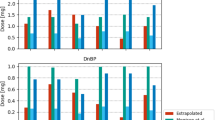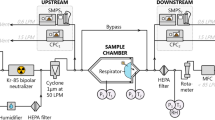Abstract
Developmental efforts and experimental data that focused on quantifying the transfer of particles on a mass basis from indoor surfaces to human skin are described. Methods that utilized a common fluorescein-tagged Arizona Test Dust (ATD) as a possible surrogate for housedust and a uniform surface dust deposition chamber to permit estimation of particle mass transfer for selected dust size fractions were developed. Particle transfers to both wet and dry skin were quantified for contact events with stainless steel, vinyl, and carpeted surfaces that had been pre-loaded with the tagged test dust. To better understand the representativeness of the test dust, a large housedust sample was collected and analyzed for particle size distribution by mass and several metals (Pb, Mn, Cd, Cr, and Ni). The real housedust sample was found to have multimodal size distributions (mg/g) for particle-phase metals. The fluorescein tagging provided surface coatings of 0.11–0.36 ng fluorescein per gram of dust. The predominant surface location of the fluorescein tag would best represent simulated mass transfers for contaminant species coating the surfaces of the particles. The computer-controlled surface deposition chamber provided acceptably uniform surface coatings with known particle loadings on the contact test panels. Significant findings for the dermal transfer factor data were: (a) only about 1/3 of the projected hand surface typically came in contact with the smooth test surfaces during a press; (b) the fraction of particles transferred to the skin decreased as the surface roughness increased, with carpeting transfer coefficients averaging only 1/10 those of stainless steel; (c) hand dampness significantly increased the particle mass transfer; (d) consecutive presses decreased the particle transfer by a factor of 3 as the skin surface became loaded, requiring ∼100 presses to reach an equilibrium transfer rate; and (e) an increase in metals concentration with decreasing particle size, with levels at 25 μm typically two or more times higher than those at 100 μm — consistent with the earlier finding of Lewis et al. for the same sample for pesticides and polycyclic aromatic hydrocarbons (PAHs).
This is a preview of subscription content, access via your institution
Access options
Subscribe to this journal
Receive 6 print issues and online access
$259.00 per year
only $43.17 per issue
Buy this article
- Purchase on Springer Link
- Instant access to full article PDF
Prices may be subject to local taxes which are calculated during checkout





Similar content being viewed by others
Abbreviations
- ASTM:
-
American Society for Testing Materials
- ATD:
-
Arizona Test Dust
- EPA:
-
Environmental Protection Agency
- LWW:
-
Lioy–Wainmann–Wiesel (LWW) surface sampler
- NHEXAS:
-
National Human Exposure Assessment Survey
- PTI:
-
Powder Technology, Inc.
- RSD:
-
relative standard deviation
- RTI:
-
Research Triangle Institute
References
Adgate JL Weisel C Wang Y Rhoads GG and Lioy PJ, Lead in house dust: relationships between exposure metrics. Environ. Res. (1995) 70: 134–147
Antley JT Vanderpool RW and Harper SL (1997)A computer-controlled system for generation of uniform dust surface deposits for dust collection and processes studies. In: Abstracts of the 7th Annual Meeting of the International Society of Exposure Analysis, Research Triangle Park, NC, November 2–5, 1997
ASTM, Standard practice for collection of dislodgeable residues from floors. ASTM D 6333-98. Annual Book of ASTM Standards. Vol. 11.03. West Conshohoken, PA 1998
ASTM, Standard laboratory test method for evaluation of carpet-embedded dirt removal effectiveness of household vacuum cleaners. Method F608-99 American Society for Testing and Materials, Conshohoken, PA 1999
Black KG and Fenske RA, Dislodgeability of chlorpyrifos and fluorescent tracer residues on turf: comparison of wipe and foliar wash sampling techniques. Arch. Environ. Contam. Toxicol. (1996) 31: 563–570
Calabrese EJ Stanek EJ and Barnes R, Methodology to estimate the amount and particle size of soil ingested by children: implications for exposure assessment at waste sites. Regul. Toxicol. Pharmacol. (1996) 24: 264–268
Camann DE, Private communication to Rodes C.E. Research Triangle Institute, Research Triangle Park, NC, February 1997
Camann DE Majumdar TK Harding HJ Ellenson WD and Lewis RG, Transfer efficiency of pesticides from carpet to saliva-moistened hands. In: Measurements of Toxic and Related Air Pollutants, VIP-64. Air and Waste Management Association, Pittsburgh, PA, 1996 pp.532–540
Cohen BM and Popendorf W, A method for monitoring dermal exposure to volatile chemicals. Am. Ind. Hyg. Assoc. J. (1989) 50(4)216–223
Cohen-Hubal E, Sheldon L, Burke J, McCurdy T, Berry M, Rigas M, Zartarian V, and Freeman N, Children's exposure assessment: a review of factors influencing children's exposure, and the data available to characterize and assess the exposure. Environ. Health Perspect. (2000) 108(6)475–486
Corn M, Adhesion of particles. In: Davies C.N. (Ed.), Aerosol Science. Academic Press, New York, NY 1996
Duggan MJ Inskip MJ Rundle SA and Moorcroft JS, Lead in playground dust and on the hands of schoolchildren. Sci. Total Environ. (1985) 44: 65–79
Edwards R, and Lioy PJ, The EL sampler: a press sampler for the quantitative estimation of dermal exposure to pesticides in housedust. J. Expos. Anal. Environ. Epidemiol. (1999) 9: 521–529
Fenske RA, Correlation of fluorescent tracer measurements of dermal exposure and urinary metabolite excretion during occupational exposure to malathion. Am. Ind. Hyg. Assoc. (1988) 49: 438–444
Fenske RA, Dermal exposure assessment techniques. Ann. Occup. Hyg. (1993) 37(6)687–706
Kim YP Pun BKL Chan CK Flagan RC and Seinfeld JH, Determination of water activity in ammonium sulfate and sulfuric acid mixtures using levitated single particles. Aerosol Sci. Technol. (1994) 20: 275–284
Kissel JC, Characterization of soil adherence to skin: impact of historical misinterpretation of the Que Hee et al. data. Risk Anal. (1995) 15(6)613–614
Kissel JC Richter KY and Fenske RA, Factors affecting soil adherence to skin in hand-press trials. Bull. Environ. Contam. Toxicol. (1996) 56: 722–728
Lanphear BP Emond M Jacobs DE Weitzman M Tanner M Winter NL Yakir B and Eberly S, A side-by-side comparison of dust collection methods for sampling lead-contaminated house dust. Environ. Res. (1995) 68: 114–123
Lewis RG Fortmann RC and Camann DE, Evaluation of methods for monitoring the potential exposure of small children topesticides in the residential environment. Arch. Environ. Contam. Toxicol. (1994) 26: 37–46
Lewis RG Fortune CR Willis RD Camann DE and Antley JT, Distribution of pesticides and polycyclic aromatic hydrocarbons in house dust as a function of particle size. Environ. Health Perspect. (1999) 107(9)721–726
Lioy PJ Wainman T and Wiesel C, A wipe sampler for the quantitative measurement of dust on smooth surfaces: laboratory performance studies. J. Expos. Anal. Environ. Epidemiol. (1993) 3: 315–330
McArther B, Dermal measurement and wipe sampling methods: a review. Appl. Occup. Environ. Hyg. (1992) 7(9)599–606
Nishioka MG Burkholder HM Brinkman MC Gordon SM and Lewis RG, Measuring transport of lawn-applied herbicide acids from turf to home: correlation of dislodgeable 2,4-D turf residues with carpet dust and carpet surface residues. Environ. Sci. Technol. (1996) 30(11)3313–3320
Pellizzari E, Lioy P, Quackenboss J, Whitmore R, Clayton A, Freeman N, Waldman J, Thomas K, Rodes C, and Wilcosky T, Population-based exposure measurements in EPA region 5: a phase I field study in support of the national human exposure assessment survey. J. Expos. Anal. Environ. Epidemiol. (1995) 5(3)327–358
QueHee SS Peace B Clark CS Boyle JR Bornschein RL and Hammond PB, Evolution of efficient methods to sample lead sources, such as house dust and hand dust, in the homes of children. Environ. Res. (1985) 38: 77–95
Ranade MB, Adhesion and removal of fine particles on surfaces. Aerosol Sci. Technol. (1987) 7: 161–176
Reed KJ Freeman NCG Lioy P Jimenez M and Quackenboss J, Quantification of children's hand and mouthing activities through a videotaping methodology. In: Abstracts of the 7th Annual Meeting of the International Society of Exposure Analysis, Research Triangle Park, NC, November 2–5, 1997
Roberts JW Budd WT Ruby MG Bond AE Lewis RG Wiener RW and Camann DE, Development and field testing of a high volume sampler for pesticides and toxics in dust. J. Expos. Anal. Environ. Epidemiol. (1991) 1(2)143–155
Roberts JW Clifford WS Glass W and Hummer PG, Reducing dust lead, dust mites, bacteria, fungi in carpets by vacuuming. Environ. Contam. Toxicol. (1999) 36(4)477–484
Rodes CE Peters TM Lawless PA and Wallace L, Aerosol sampling biases in personal exposure measurements. In: Abstracts of the 6th Annual Meeting of the International Society of Exposure Analysis, New Orleans, LA, December 12, 1996
Rodes CE Newsome JR and Quackenboss JJ, Aerosol mass transfer measurements in support of NHEXAS dermal exposure. In: Abstracts of the 7th Annual Meeting of the International Society of Exposure Analysis, Research Triangle Park, NC, November 2–5, 1997
Sayre JW Charney E Vostal J and Pless IB, House and hand dust as a potential source of childhood lead exposure. Am. J. Dis. Child (1974) 127: 167–170
Thompson DG Stephenson GR and Sears MK, Persistence, distribution and dislodgeable residues of 2,4-D following its application to turfgrass. Pestic. Sci. (1984) 15: 353–360
U.S. EPA, Comparison of methods to determine dislodgeable residue transfer from floors. Report EPA/600/R-96-089 U.S. Environmental Protection Agency, Research Triangle Park, NC 1996
Vaccaro J, Evaluation of dislodgeable residues and absorbed dose following indoor broadcast applications of chlorpyrifos-based emulsifiable concentrate. In: Abstracts of 11th Annual Meeting of the Society of Environmental Toxicology and Chemistry, Washington, DC, 1990
Wang E Rhoads GG Wainman T and Lioy PJ, Effects of environmental and carpet variables on vacuum sampler collection efficiency. Appl. Occup. Environ. Hyg. (1995) 10(2)111–119
Zartarian VG and Leckie JO, Dermal exposure: the missing link. Environ. Sci. Technol. News. March 1, 1998
Zimon AD, Adhesion of Dust and Powder, All-Union Scientific Research Institute of the Food Industry, Moscow (USSR). Plenum Publishing (Consultants Bureau), New York, NY 1982 Translated by Johnston R.K
Acknowledgements
The assistance of Dr. Nora Castillo provided the initial design of the fluorescein tagging apparatus used for the test dust. Sharon Harper (EPA/NERL) provided assistance in planning the collection and processing of the housedust sample described in this work. Dr. Peter Grohse at RTI conducted the extractions and ICP/MS metals analyses for the bulk housedust sample. The U.S. Environmental Protection Agency, through its Office of Research and Development, partially funded, assisted in the management, and collaborated in the research described here under contract 68-D5-0040-WA019-WA023 to the Research Triangle Institute. It has been subjected to Agency review and approved for publication. Mention of trade names or commercial products does not constitute endorsement or recommendation for use.
Author information
Authors and Affiliations
Corresponding author
Rights and permissions
About this article
Cite this article
RODES, C., NEWSOME, J., VANDERPOOL, R. et al. Experimental methodologies and preliminary transfer factor data for estimation of dermal exposures to particles. J Expo Sci Environ Epidemiol 11, 123–139 (2001). https://doi.org/10.1038/sj.jea.7500150
Received:
Accepted:
Published:
Issue Date:
DOI: https://doi.org/10.1038/sj.jea.7500150
Keywords
This article is cited by
-
Model based prediction of age-specific soil and dust ingestion rates for children
Journal of Exposure Science & Environmental Epidemiology (2022)
-
Soil ingestion among young children in rural Bangladesh
Journal of Exposure Science & Environmental Epidemiology (2021)
-
Early detection of viable Francisella tularensis in environmental matrices by culture-based PCR
BMC Microbiology (2020)
-
Age-related changes to environmental exposure: variation in the frequency that young children place hands and objects in their mouths
Journal of Exposure Science & Environmental Epidemiology (2020)
-
Experimental estimation of migration and transfer of organic substances from consumer articles to cotton wipes: Evaluation of underlying mechanisms
Journal of Exposure Science & Environmental Epidemiology (2016)



